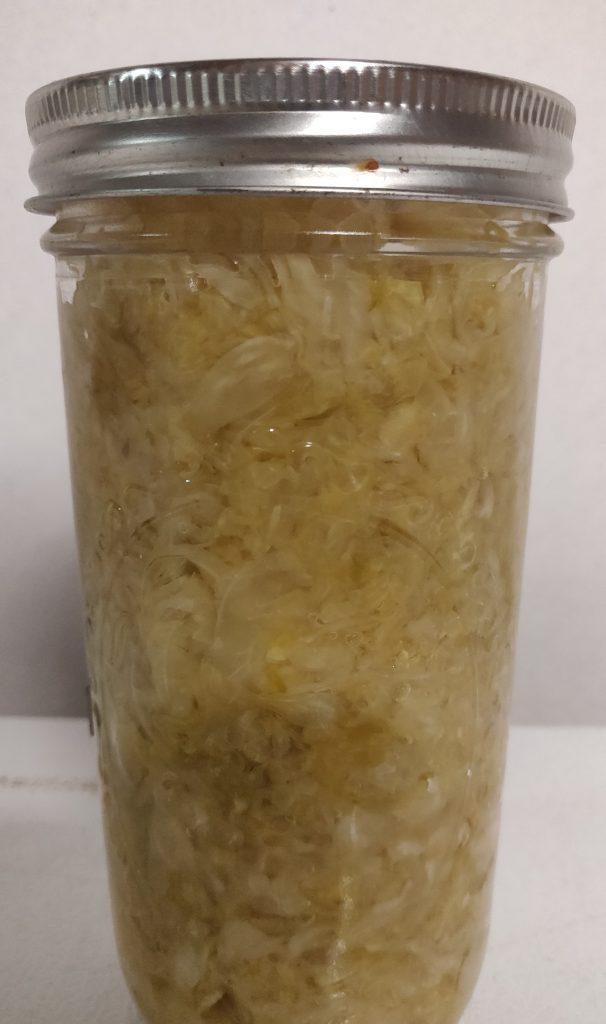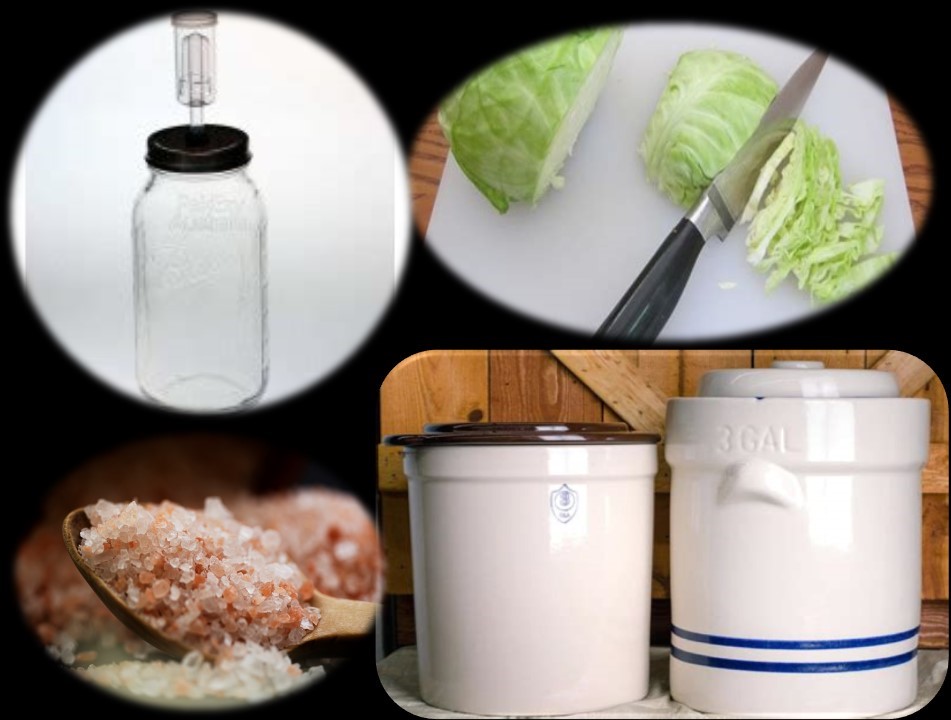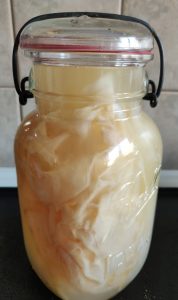
Sauerkraut is so good for your gut!, it is SIMPLE to make, and it tastes great!
Lets start with some background on how sauerkraut came to be! Look what Wikipedia has to say. Now that you know its not a “German Dish” and know now that its been around over 2000 years! Why? because “fermenting” is a great way to make food SHELF STABLE, and although not the only way, it was one of the only way’s before modern day canning. We have all heard stories of people and societies drying fish, or smoking meat to preserve it. Fermentation was the best way for many many years and is still used to this day for lots of foods! Now let’s talk about Sauerkraut!
Making SAUERKRAUT is so simple! most people start off making small batches either in a quart, half gallon or gallon jar. What you will find out, is that it is so good, you will have that small batch eaten and gone before you even are able to start a second batch! I use a 3 gallon crock, it makes approx 8 quarts of sauerkraut.
Before we get into the particulars, lets talk about TIME ….Fermentation takes time! not days, but weeks! Now you know why I make bigger batches! If you have 8-10 glass 1 gallon jars, you could start a batch maybe weekly or twice monthly and have a steady supply of fresh, crispy, yummy sauerkraut! Your probably wondering, “why does it take so long” well without going into all the scientific terms, oh ok, here is the scientific term:
zymology or zymurgy. Just let me put it simply, Fermentation is a metabolic process that converts sugar to acids, gases or alcohol. It occurs in yeast and bacteria.
This is so interesting! and if you did not know it, fermented foods are very very good for your gut health! Here is a great article on WEBMD about it!
What You Will Need

The basic things you will need to make sauerkraut are, Cabbage, a knife, big bowl, salt ( I use course SEA SALT), and a Jar with an airlock lid (you can find all kinds of them on Amazon Just do a search for airlock lids. OR you can use a crock with a water seal fermentation lid. You can get those here.
Now Let’s make your sauerkraut!
1.Start by using FRESH cabbage, then by washing your cabbage well! It is important to wash your cabbage, if store bought, it was probably sprayed with harmful pesticides, if you grew it, it may not have pesticides, but may have cabbage worms. I fill my sink with cold water, I then pour in some HOMEMADE ACV, the worms hate it and will crawl out of your cabbage.
2.It will take approx one 2lb head of cabbage per quart jar. In my 3 Gallon crock I used 8 to 10 big 3lb heads of cabbage. Slice cabbage thinly with the knife. Put the cabbage in a big bowl, with enough room for it to move around, sprinkle with salt. If doing smaller batches you can do this all at once, In my 3 Gallon crock, it takes me approx 4 bowls to do it all. Once the bowl is about 1/2 to 2/3 full of cabbage and you have sprinkled salt on it, now comes time for some good ole’ fashion elbow grease! NOTE: you may wish to wear clean, sanitary latex gloves. your going to actually knead, crunch and crush the cabbage with the salt so that you release the water. Are you aware that cabbage is approx 93% water! Knead your cabbage and salt for about 10-15 mins then let sit for about 30 mins. Check it, you may wish to knead it again, to release more of the water.
3.Take the cabbage, with the water and put it into your glass container or crock, and punch it down so that it is fully submerged under the “brine” that came from kneading the cabbage. It is important to FILL YOUR CONTAINER almost to the top, do not be afraid to pack it down with your fist. why? To turn cabbage into sauerkraut, you must have and ANEROBIC atmosphere. This means NO oxygen. So you will want your container almost full with as little room as possible for oxygen.
4.Once your container is almost full, and you have made sure it is punched down and fully covered with brine, (if not, add some water to make sure its covered.) You now want to cover your cabbage. You can use cheesecloth, but I prefer to take some of the bigger outside leaves that came off the cabbage and use them to cover all the cabbage, and I DOUBLE CHECK TO MAKE SURE IT IS ALL SUBMERGED UNDER THE BRINE. Now you want to weigh it down. If using a crock, they will come with weights, add them at this point. If using a glass jar, use a smaller jar filled with marbles to weigh down your cabbage.
5.Now you need to make it airtight. If using a jar with an airlock, follow the directions, if using a crock with a water seal, put the lid on and fill the water well. Find a place that is room temperature and let sit for about 2 weeks. Check the water well of your crock to make sure it does not evaporate, add water as needed to keep your seal.
After about 2 weeks, you can check your sauerkraut, I have found that 3-6 weeks makes the best sauerkraut. Taste is every week or so, and jar it when you feel its tangy enough for you!
Note: It is normal to see bubbles, white scum, or foam on top during the fermentation. You shouldn’t see any actual mold, though. If you do, scrape it off the top, and make sure all the rest of the cabbage is fully submerged. All cabbage below the brine level should still be fine.
How to store your fresh made sauerkraut
Keep the temperature moderate. In my experience, Sauerkraut is best when fermented at around 65-67 degrees, though anything in the 60-70 degree range works well. If it drops below the 65, fermentation tends to be very slow. any higher than that, it is too fast and you will have a mushy finished product. Cabbage is often freshest in cooler months, and counter temperatures are perfect at these times. In warmer months, store it in your fridge, or just make sure it is in a cool, dark corner of the pantry. You can start eating your sauerkraut right away, or you can jar it and store it in the fridge. I do jar mine and store it in the cool basement, under 50 degrees. You will find that it will stay just fine for 6 months in your fridge or other cool storage. Mine never lasts that long!
There are lots of variables you can do when making your sauerkraut. Everything from caraway seeds, to garlic
Health Benefits of Fresh Sauerkraut
Are you aware that your fresh sauerkraut is packed full of probiotics! This is good bacteria that aids in digestion and gut flora
Cabbage is a great source of vitamins B and C, and because its now fermented the bio availability for your body is even greater than eating plain cabbage!
The Bottom line, is Sauerkraut is simple to make, easy to keep and very very good for you! Enjoy it with lots of side dishes!

